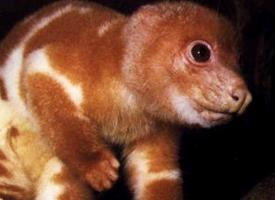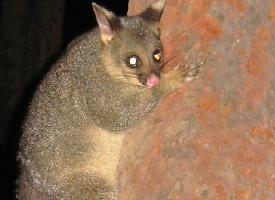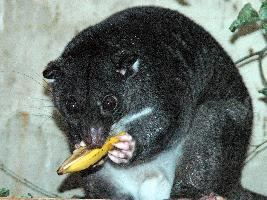
Váhy a míry
| Délka | od 35 do 45 cm |
|---|---|
| Hmotnost | od 1,5 do 3,5 kg |
Biologická data
| Délka života | 10 r |
|---|
Popis zvířete
The Common Spotted Cuscus (Spilocuscus maculatus) is a distinctive marsupial native to the tropical forests of New Guinea and parts of the Cape York Peninsula in Australia. This unique animal is part of the Phalangeridae family, which encompasses a variety of possum-like creatures known for their arboreal lifestyles.Characterized by its striking appearance, the Common Spotted Cuscus has a robust body covered in soft, woolly fur that can vary in color. Typically, its coat ranges from creamy white to various shades of brown, adorned with irregular spots or blotches that provide excellent camouflage among the forest canopy. This patterning is not only beautiful but also highly variable, with some individuals displaying almost entirely white coats, while others may appear predominantly dark brown or black.
The face of the Common Spotted Cuscus is round with large, forward-facing eyes that grant it excellent night vision, a critical adaptation for its nocturnal lifestyle. Its ears are small and often partially hidden in its thick fur. One of the most remarkable features of this marsupial is its prehensile tail, which is almost as long as its body. This tail is furless at the tip, allowing the cuscus to grasp branches securely as it navigates the complex forest canopy in search of food.
Measuring up to 60 cm (about 24 inches) in body length, with the tail adding another similar length, the Common Spotted Cuscus is among the larger members of its family. Despite its size, it is a slow-moving animal, relying more on stealth and camouflage than speed to avoid predators, which include birds of prey and large snakes.
The diet of the Common Spotted Cuscus is primarily herbivorous, consisting of leaves, fruits, flowers, and occasionally small insects or eggs. Its strong jaws and sharp teeth are well-adapted to breaking down tough plant material, although it shows a preference for softer, more easily digestible foods when available.
Reproduction in the Common Spotted Cuscus follows a typical marsupial pattern, with females giving birth to extremely underdeveloped young that continue their development in the safety of the mother's pouch. This period of pouch life lasts several months, during which the young are dependent on their mother's milk and protection.
As an arboreal creature, the Common Spotted Cuscus plays a vital role in its ecosystem, aiding in seed dispersal and thus contributing to the health and diversity of its forest habitat. However, like many forest-dwelling animals, it faces threats from habitat destruction due to logging, agriculture, and expanding human settlements.
Despite these challenges, the Common Spotted Cuscus has proven resilient in parts of its range, though its population is believed to be declining. Conservation efforts aimed at preserving its habitat are crucial for ensuring the survival of this unique and fascinating marsupial for future generations to admire and study.
Mapa výskytu

Podobná zvířata
Nové fotografie zvířat
Top 10 zvířat
- Chinese water dragon (Physignathus cocincinus)
- Galápagos tortoise (Geochelone nigra complex)
- Dolphin gull (Leucophaeus scoresbii)
- Japanese macaque (Macaca fuscata)
- Colombian red howler (Alouatta seniculus)
- Sea urchins (Echinoidea)
- Moustached guenon (Cercopithecus cephus)
- Diana monkey (Cercopithecus diana)
- Common reed warbler (Acrocephalus scirpaceus)
- Common house mosquito (Culex pipiens)

